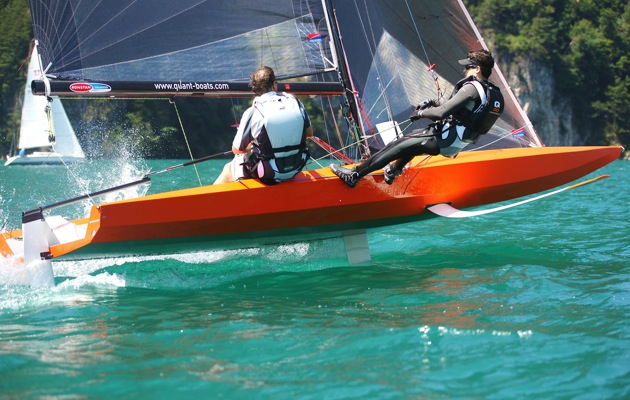The Quant 23 is a boat that puts the sparkle back into everyman sailing, whether you want to fly or not
All this foiling malarkey turns a lot of people off. The pumped-up, Red Bull-fuelled adrenaline junkies flying around on ludicrously expensive exotic mulitihulls – before falling of the skinny foils at break-neck speeds. It may be great to watch in short bursts, but the reality is very far removed from conventional sailing.
The only realistic options for those who want to experience flight on the water is perhaps a course in the highly skilled and delicate art of Moth sailing (a diet may also be required) – or to hop aboard a hydrofoiling ferry.
The Gunboat G4 is another choice of course – if you happen to be a millionaire with enough bravado to match your deep pockets, Holland Composites will build you one
Thankfully more realistic alternatives are arriving. In the August issue for example Matt reported on the Whisper cat.
When I first saw the pictures of this Quant 23 foiling off Cowes this summer however, I admit to being pessimistic… A foiling keelboat? And with such a ‘different’ shape? It could never work, could it?
I am delighted to report that my misgivings have been proven wrong.
Last week I finally had the chance to get up close and personal to the Quant 23 during European Yacht of the Year trials in Italy. Through speaking with Quant’s founder Michael Aeppli and her designer Hugh Welbourn, the creator of the Dynamic Stability System (DSS), I came to realise and appreciate this project properly. (See the full description of this ‘gentleman’s foiler’ as they describe her HERE)
Along with my fellow judges we spent most of the week praying for more than the average 2-5 knot zephyrs to see if this orange skimming dish would fly. And during our final day, and our one brief spell of 8-11 knots breeze, that happened. Two Scandinavian members of our jury, both foiling virgins, flew on their first outing, an eye-opening display in front of the other envious judges.

The Quant 23 takes flight during our European Yacht of the Year trials in Italy – note how little breeze there is on the surface
But whether it was while outpacing all of the other boats in light breeze displacement mode aboard the Quant or witnessing her take flight, two things stood out:
- I can’t quite believe Quant’s creators had never heard of Dukes of Hazzard – if this isn’t a spitting image of the starring Dodge Charger called General Lee, what is? I have a strong feeling the tango coloured Quant, the contemporary scow, has the brash ability take on a cult status in the sailing world too.
- Don’t look at this as purely the world’s ‘first foiling keelboat’ – which is what all the hype will make you believe. No, this is, first and foremost, an awesome sportsboat. Visionary British designer Hugh Welbourn drew her for lake sailing in Switzerland – where 80 per cent of the time Aeppli sails in less than 10 knots he says.
The superlight scow platform looks different and provides a stable raft from which to enjoy high-speed fun (preferably in flat water!). This is no twitchy carbon toothpick, the Quant has a large cockpit and plenty of space for real amateur to get accustomed to her, or even hang out on the wire.
But those vast foils mean the Quant 23 has two other modes. The first is DSS stability: push the curved boards half way down so they are only slightly submerged and you have two giant stabilisers adding to an already stable platform.
Rather than just providing leeward lift for righting moment though, these boards, combined with a T-foil rudder, provide enough lift for full flight. So foiling is the third mode, the turbo, and one that is achievable in very little wind too (around 10 knots). Easy flight in low wind speeds was always the goal over top end speed – something I think Quant has achieved.
Here is a video I took onboard showing the foils, explained by Michael Aeppli, and showing the relative simplicity of the boat.
Most importantly this is an approachable, fun boat. Rather than trying to conform to a one-design class or trying to rate to any rules, it simply puts the all-out excitement back into day sailing. From the moment you set eyes on the Quant 23, you will remain intrigued. And you certainly won’t want to step off it in a hurry. Take a less experienced crewmember out – stick them out on the wire – and enjoy new age sailing.
“If you can sail a dinghy properly, you can sail our boats,” says Aeppli. “It’s a raft, a very stable shape, a skimming dish if you fall off the foils, but one that’s also very pleasant to sail without foils,” Welborn agrees. The scow provides stability against nose-diving, and if you fall over, one person can stand on the bulbed keel and right it (the hull weighs just 130kg).
“This boat is an exercise in logic,” Welbourn continued. “An easy to sail sportsboat or a foiling boat for Joe Bloggs.”
This is the prototype model, before Quant goes into production with the 23 with very few changes. At €60–65k it’s still perhaps prohibitively expensive for many. But think about the ramifications of this design. Many of us will have grown up sailing a Topper or even a Fireball, and will know the forgiving yet exciting possibilities of a scow-shaped dinghy. Add in the performance of a Flying Dutchman, with 60 years of technology gains and you start to get the picture.
Scale this super-charged Quant 23 down one notch in length, and you have a two-man sports scow. And then perhaps a single-handed dinghy version? Where do I sign?!









